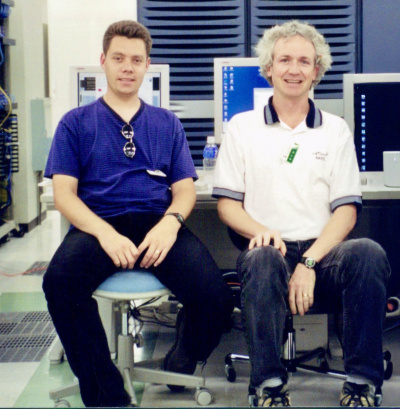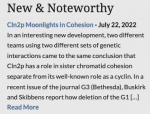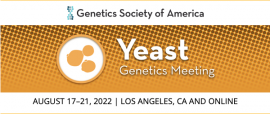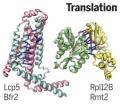New & Noteworthy
SGD Newsletter, December 2025
December 11, 2025
About this newsletter:
This is the December 2025 issue of the SGD newsletter. The goal of this newsletter is to inform our users about new features in SGD and to foster communication within the yeast community.
Contents
- 1 Support SGD this Holiday Season
- 2 New at SGD: Links to a Comprehensive Overview of Yeast Libraries
- 3 Retirement of Mike Cherry
- 4 Reminder: Submit Data Form
- 5 Alliance of Genome Resources News
- 6 microPublications – Latest Yeast Papers
- 7 Upcoming Conferences & Courses
- 8 Happy Holidays from SGD!
Support SGD this Holiday Season
Budget cuts from NIH continue to strain SGD’s finances. Despite our efforts at reducing costs, we still have significant ongoing budgetary challenges. Donations are now critical for our work to continue. Your generous gift to SGD enables us to continue providing essential information for your research and teaching efforts. We are now able to accept gifts via credit card. To contribute using a credit card, please use this form: give.stanford.edu.
- Under ‘Direct your gift,’ select ‘Other Stanford Designation’ from the pulldown menu
- In the ‘Other’ text box, specify SGD by including the text “Saccharomyces Genome Database – Account : GHJKO, Genetics : WAZC”
- Complete the form and payment to donate to SGD
If you’d like to contribute by check, please contact us at: sgd-helpdesk@lists.stanford.edu
We thank you in advance for your support!
New at SGD: Links to a Comprehensive Overview of Yeast Libraries

Baruch et al. have compiled and published A comprehensive overview of yeast libraries and their role in advancing cell biology, which describes a comprehensive list of genome-wide collections of Saccharomyces cerevisiae. They have grouped similar strain libraries together and have curated detailed descriptions, mating types, genotypes, references, and genome coverage. This information can help researchers identify strain libraries of interest to them. All of this information can also be found in tables on LibrarYeast. We have added links to these tables under the Resources section of individual Protein, Phenotype, and Interaction tabs.

Retirement of Mike Cherry
This year, we celebrate and thank J. Michael “Mike” Cherry as he retires after decades of visionary leadership of the Saccharomyces Genome Database. From the earliest days of the yeast genome to today’s multi‑omic era, Mike helped shape SGD into the trusted, rigorously curated resource at the heart of the yeast community. His commitment to high‑quality data, interoperability, and open science empowered discoveries around the world, and his mentorship nurtured generations of curators, developers, and collaborators. Mike’s steady guidance, big‑picture thinking, and relentless focus on serving researchers have left a lasting legacy that will continue to guide SGD’s mission.
On November 14th, many past and current Cherry lab members gathered at Stanford to celebrate Mike’s career. Thank you to everyone who attended, and especially to everyone that shared stories or memories from the past 3 decades of SGD. Gavin Sherlock is SGD’s new PI, and he is hardly a stranger to SGD! Mike and Gavin published their first article together about SGD in Science all the way back in 1998: Chervitz et al., Comparison of the Complete Protein Sets of Worm and Yeast: Orthology and Divergence.
On behalf of the SGD team and the global yeast community, we extend our deepest gratitude to Mike and wish him joy and fulfillment in the next chapter.
Thank you, Mike, for everything.

Reminder: Submit Data Form
If you’re itching for something to do over the winter break, have you checked your newly published data at SGD lately? SGD can use your help! Authors can submit data and information about their publications by pointing us to novel results, datasets (we appreciate GEO accession IDs!), or other important information, using SGD’s simple “Submit Data” form: https://www.yeastgenome.org/submitData.
Alliance of Genome Resources News
Alliance of Genome Resources – Latest Release 8.2.0
The 8.2.0 release includes data refreshes from each of the model organism source databases as well as various backend improvements. The sequence viewers on the gene and allele pages have been restored on gene pages, in the Alleles and Variants and Sequence Feature Viewer sections, and on allele pages, in the Genomic Variant Information section (see for example the mouse gene Pten and mouse allele for Pten). Also, on the gene page Alleles and Variants section, interactions between the variant sequence viewer and the alleles/variants table have been restored. Website infrastructure is upgraded to React 19 and migrated to Vite.
Alliance Webinars: MicroPublication Biology
On November 20, Tim Schedl, microPublication Biology Editorial Board member, presented an overview of the MicroPublication journal which publishes brief scholarly reports of research findings based on data presented in a single figure. View the recording of the latest Alliance of Genome Resources webinar: Introduction to MicroPublication Biology. Webinars are also planned for 2026, in January, February, and March. See the Event Calendar for the schedule of upcoming Alliance office hours and webinars.
FlyBase End of Funding
The termination of the NIH/NHGRI FlyBase grant has placed the long-term sustainability of FlyBase at risk. However, thanks to the generous support of several key individuals and institutions, FlyBase has announced that they will remain operational through the coming year. Looking ahead, ensuring FlyBase’s sustainability beyond the next year – and successfully integrating with the Alliance – will require new funding sources. FlyBase, like SGD, is asking for continued donations from any and all Fly supporters. For more information on how to support FlyBase, see the FlyBase wiki:
- European labs: Please consider contributing to the Cambridge, U.K. FlyBase group
- U.S. and other non-European labs: Please consider contributing to the U.S. FlyBase groups
Final Release of WormBase
WormBase announced their final release, WS298, on November 27, 2025. The existing WormBase website will continue provide access to this archived WS298 release of WormBase, and the content hosted there will no longer be updated except for essential maintenance to ensure continued availability. Ongoing curation, annotation, data updates, and new data for Caenorhabditis elegans will now be managed through the Alliance of Genome Resources. Users should refer to the Alliance for the most current worm datasets and continued resource development. Read more on the WormBase blog.
microPublications – Latest Yeast Papers
microPublication Biology is part of the emerging genre of rapidly-published research communications. microPublications publishes brief, novel findings, negative and/or reproduced results, and results which may initially lack a broader scientific narrative. Each article is peer-reviewed, assigned a DOI, and indexed through PubMed and PubMedCentral. Consider microPubublications when you have a result that doesn’t necessarily fit into a larger story, but will be of value to others. Latest yeast microPublications:
- King A, Emery TM, Reese K, Tinsley HN (2025) Yeast gene of unknown function YGL081W is involved in DNA damage response. MicroPubl Biol 2025
- Avogo EW, Burlingame NA, Badenahalli Narasimhaiah S, Delorme-Axford E (2025) Bioinformatics analysis identifies Mot2 protein as a potential regulator of autophagy in Saccharomyces cerevisiae. MicroPubl Biol 2025
- Nnabuenyi N, Sands MA, Camlin NJ (2025) Specific auxin and medium combinations alter Saccharomyces cerevisiae growth. MicroPubl Biol 2025
- Sasahara M, Matsumoto S, Tamura Y (2025) Dnm1 Is Required for the Focal Clustering of Fis1 on the Mitochondrial Outer Membrane. MicroPubl Biol 2025
- Dutca LM, Freed EF, Baserga SJ (2025) Yeast pre-rRNA is processed at the A’ site. MicroPubl Biol 2025
- Schiemann AH, Sarwar M, Sattlegger E (2025) Functional Analysis of the Yeast Counterpart to the Human GCN2 p.Glu738_Asp739insArgArg Variant. MicroPubl Biol 2025
- Torvi JR, Wong J, Drubin DG, Barnes G (2025) Stu2 is required for plus-end directed chromosome transport along microtubules during metaphase in Saccharomyces cerevisiae. MicroPubl Biol 2025
- VanderVen K, Butcher C, Fokine R, Li J (2025) Pep12 is important for proteasome microautophagy under low glucose conditions. MicroPubl Biol 2025
- Tang L, AlKaabi A, Meyer D (2025) Copper Homeostasis is influenced by Ics3 in Saccharomyces cerevisiae. MicroPubl Biol 2025
- Taguchi S, Matsuzawa R, Suda Y, Irie K, Ozaki H (2025) Investigating the effects of liquid handling robot pipetting speed on yeast growth and gene expression using growth assays and RNA-seq. MicroPubl Biol 2025
- Takesue H, Okada S, Ito T (2025) Long-read plasmid sequencing strategy for evaluating intrinsic instability of tandem gene arrays. MicroPubl Biol 2025
Upcoming Conferences & Courses
- 33rd Fungal Genetics Conference
- March 17 to March 22, 2026 –
- Asilomar Conference Grounds, Pacific Grove, CA
- Yeast Genetics Meeting 2026
- June 13 to June 17, 2026 –
- Asilomar Conference Grounds, Pacific Grove, CA
- 39th International Specialized Symposium on Yeasts (ISSY39)
- Nov 8 – 12, 2026
- Jeongdong 1928 Art Center, Seoul, KR
Happy Holidays from SGD!
We want to take this opportunity to wish you and your family, friends, and lab mates the best during the upcoming holidays. Stanford University will be closed for two weeks starting end of day Friday, December 19th, and reopening on Monday, January 5th, 2026. Although SGD staff members will be taking time off, the website will be up and running throughout the winter break, and we will resume responding to user requests and questions in the new year.
Note: If you wish to receive this newsletter via email, please contact the SGD Help Desk at sgd-helpdesk@lists.stanford.edu.
Categories: Newsletter
SGD Newsletter, Spring 2025
April 30, 2025
About this newsletter:
This is the Spring 2025 issue of the SGD newsletter. The goal of this newsletter is to inform our users about new features in SGD and to foster communication within the yeast community.
Contents
- Give a Gift / Support SGD: Credit Cards Now Accepted
- SGD’s Latest Genetics Publication
- Pathway Annotations Now Available as GO Annotations
- New Yeast Phenome Links in Phenotype Resources
- microPublications – Latest Yeast Papers
- Alliance of Genome Resources – Latest Release 8.1.0
- Upcoming Conferences & Courses
Give a Gift / Support SGD: Credit Cards Now Accepted

Budget cuts from NIH continue to strain SGD’s finances. Despite our efforts at reducing costs, we still have significant ongoing budgetary challenges. Donations are now critical for our work to continue.
Your generous gift to SGD enables us to continue providing essential information for your research and teaching efforts. We are now able to accept gifts via credit card.
To contribute using a credit card, please use this form: give.stanford.edu.
- Under ‘Direct your gift,’ select ‘Other Stanford Designation’ from the pulldown menu
- In the ‘Other’ text box, specify SGD by including the text “Saccharomyces Genome Database – Account : GHJKO, Genetics : WAZC”
- Complete the form and payment to donate to SGD
If you’d like to contribute by check, please contact us at: sgd-helpdesk@lists.stanford.edu
Thank you for your support!
SGD’s Latest Genetics Publication

Saccharomyces Genome Database: Advances in Genome Annotation, Expanded Biochemical Pathways, and Other Key Enhancements has now been published in GENETICS and is available in the March 2025 issue.
Check out the most recent updates at SGD, including:
- Two most recent reference genome annotation updates
- Expanded biochemical pathways representation
- Changes to SGD search and data files
- Other enhancements to the SGD website and user interface
Pathway Annotations Now Available as GO Annotations

YeastPathways, the database of metabolic pathways and enzymes in the budding yeast Saccharomyces cerevisiae, is manually curated and maintained by the biocuration team at SGD.
This resource is jam-packed with information, but was somewhat hidden from view. We have been doing different things recently to make the pathways more readily accessible. Initially, we added a new section with pathways links on the relevant gene pages (ex. DFR1). Additionally, we made the pathways available in SGD Search. Now, we have transformed the metabolic pathways and associated genes/enzymes into Gene Ontology (GO) annotations (ex. DFR1).
Because many fundamental molecular processes and pathways are evolutionarily conserved between yeast and higher eukaryotes, including humans, the curated metabolic pathway information has great value for the transfer of knowledge to other organisms. It is for this reason that the YeastPathways data were exported in BioPAX (Demir et al. 2010) format for import into Noctua, a tool for collaborative curation of biological pathways and gene annotations that was developed by the GO Consortium (Thomas et al. 2019). BioPAX provides a standardized format for representing biological pathways, allowing researchers to integrate pathway information from different sources and databases. Noctua can import pathway data encoded in BioPAX format to populate the pathway editor with molecular interactions, biological processes, and regulatory relationships, and can utilize BioPAX files to combine pathway data from multiple datasets for pathway curation and analysis.
Pathways curated and edited in Noctua can be exported both as GO annotations for yeast and orthologous genes in other species, or as pathway annotations in BioPAX, facilitating the sharing of curated pathways with other researchers, databases, and analysis tools using a standard format, promoting data exchange, and collaboration within the scientific community.
New Yeast Phenome Links in Phenotype Resources

The Yeast Phenome is a collaborative project from the Baryshnikova lab at Calico Life Sciences to create a comprehensive compendium of systematic loss-of-function phenotypes for the budding yeast Saccharomyces cerevisiae.
The Yeast Phenome systematically tracks, collects, and annotates all published phenotypic screens utilizing the yeast knock-out collection.
Locus-specific links to the Yeast Phenome are now available in the Resources section of the Phenotype tab and will take you directly to the corresponding page of the Yeast Phenome data library. Try it now: the SGD phenotype page for ARP1, and the linked ARP1 page at Yeast Phenome.
microPublications – Latest Yeast Papers

microPublication Biology is part of the emerging genre of rapidly-published research communications. microPublications publishes brief, novel findings, negative and/or reproduced results, and results which may initially lack a broader scientific narrative. Each article is peer-reviewed, assigned a DOI, and indexed through PubMed and PubMedCentral.
Consider microPubublications when you have a result that doesn’t necessarily fit into a larger story, but will be of value to others.
Latest yeast microPublications:
- Andrade Latino A, Biggins S (2025) Analysis of a cancer-associated mutation in the budding yeast Nuf2 kinetochore protein. MicroPubl Biol 2025
- Butcher C, VanderVen K, Li J (2025) Proteasome condensates repeatedly “contact and release” at the nuclear periphery during dissolution. MicroPubl Biol 2025
- Eftimie A, Meyer D (2025) Transcription Regulatory Protein SIN3 (YOL004W) Influences Mutation Rates in Saccharomyces cerevisiae. MicroPubl Biol 2025
- James M, Klain GK, Brito SO, Trejo L, Okello TMA, Segarra VA (2025) Autophagy-deficient budding yeast cells are sensitive to freeze-thaw stress. MicroPubl Biol 2025
- Law S, et al. (2024) The Role of hBRCA2 in the Repair of Spontaneous and UV DNA Damage in Saccharomyces cerevisiae. MicroPubl Biol 2024
- Pfliegler WP, Imre A, Biotechnology BSc Class Of UOD, Pócsi I (2025) PCR-fingerprinting of culturable yeasts from commercially obtained beers: a simple and engaging applied microbiological laboratory exercise. MicroPubl Biol 2025
- Thota K, Fredette-Roman JD, Sharp NP (2025) Yeast mutation rates in alternative carbon sources reflect the influence of reactive oxygen species. MicroPubl Biol 2025
All yeast microPublications can be found in SGD.
Alliance of Genome Resources – Latest Release 8.1.0
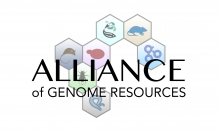
The 8.1.0 release includes data refreshes from each of the model organism source databases as well as various backend improvements.
Recent changes in 8.0.0 and 8.1.0 include:
- Redesign of the legend corrects issues with casual relationship representation; interface visuals have been refined; all defined causal relationships are now depicted using standardized glyphs with a matching color legend.
There is now an Event Calendar with the schedule of upcoming Alliance office hours and webinars: https://www.alliancegenome.org/event-calendar
- View the video of the latest Alliance of Genome Resources webinar:
- How AI informs literature curation at the Alliance
- Presented on April 17, 2025 by Kimberly Van Auken and Valerio Arnaboldi of WormBase, and Chris Tabone of FlyBase.
Upcoming Conferences & Courses
- Gene Ontology Consortium Spring 2025 Meeting
- May 5-8, 2025
- Geneva, Switzerland
- SGD will be attending
- CSH Asia: Yeast and Life Sciences
- June 02 to June 06, 2025 –
- Suzhou, China
- PNWYC 2025: Pacific Northwest Yeast Club
- June 20, 2025
- Vancouver, Canada
- Yeast2025: 32nd International Conference on Yeast Genetics and Molecular Biology ICYGMB32
- July 21 to July 24, 2025
- Sorbonne University, Paris, France
- SGD will be attending
- Yeast Genetics & Genomics
- July 22 to August 12, 2025
- Cold Spring Harbor Laboratory, Cold Spring Harbor, NY
- SGD will be attending
- 38th International Specialized Symposium on Yeasts (ISSY38)
- September 01 to September 05, 2025 –
- Warsaw University, Warsaw, Poland
- 33rd Fungal Genetics Conference
- March 17 to March 22, 2026 –
- Asilomar Conference Grounds, Pacific Grove, CA
Categories: Newsletter
SGD Newsletter, December 2024
December 13, 2024
About this newsletter:
This is the December 2024 issue of the SGD newsletter. The goal of this newsletter is to inform SGD users about new features from SGD and to foster communication within the yeast community.
Contents
- 1 AlphaFold protein structures now on SGD protein pages
- 2 YeastMine data available in AllianceMine
- 3 Help maintain your genomic databases! Sign open letter supporting funding for biodata resources
- 4 Community wiki shutting down
- 5 SGD’s new GENETICS publication
- 6 microPublications – Latest yeast papers
- 7 Alliance of Genome Resources – Latest Release 7.4
- 8 Give a Gift / Support SGD
- 9 Upcoming conferences and courses
- 10 Happy Holidays from SGD!
AlphaFold protein structures now on SGD protein pages
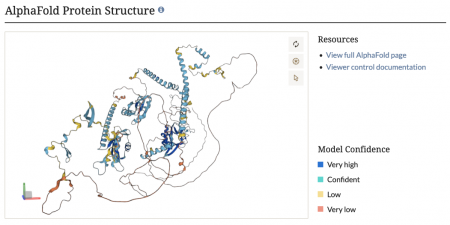
We are thrilled to announce that we have now integrated AlphaFold protein structures into our protein pages! This cutting-edge addition provides detailed, high-accuracy 3D models of protein structures, offering invaluable insights into protein function and interactions. Researchers can now explore these comprehensive structural predictions directly within SGD, facilitating advanced studies in molecular biology and bioinformatics. Dive into the new AlphaFold protein structures and elevate your research with this powerful tool!
AlphaFold, developed by DeepMind, is an AI program that accurately predicts protein structures from amino acid sequences, enabling visualization of protein conformations.
The predicted structures can be accessed through the Protein Data Bank (PDB) and AlphaFold Protein Structure Database. Thanks to Kim Rutherford and Val Wood of Pombase for tips about adding AlphaFold structures to SGD.
YeastMine data available in AllianceMine

Here at SGD we provide high-quality curated genomic, genetic, and molecular information on the genes and gene products of the budding yeast Saccharomyces cerevisiae. In 2011, SGD implemented InterMine, an open-source data warehouse system with a sophisticated querying interface, to better meet the complex and diverse needs of researchers searching and comparing data, resulting in the creation of YeastMine.
YeastMine is a multifaceted search and retrieval environment that provides access to diverse data types. Searches can be initiated with a list of genes, a list of Gene Ontology terms, or lists of many other data types. The results from queries can be combined for further analysis and saved or downloaded in customizable file formats. Queries themselves can be customized by modifying predefined templates or by creating a new template to access a combination of specific data types.
In July 2024, YeastMine was discontinued due to ongoing cuts in funding at SGD. However, we have moved the YeastMine data into AllianceMine, hosted by the Alliance of Genome Resources, of which SGD is a founding member. You can even access lists like “ALL_Verified_Uncharacterized_Dubious_ORFs” through the AllianceMine Lists just as you could in the previous versions of YeastMine. Ensure any bookmarks to YeastMine have been updated to match the new URL: https://www.alliancegenome.org/bluegenes/alliancemine. User documentation for the new YeastMine interface is available from InterMine.
Help maintain your genomic databases! Sign open letter supporting funding for biodata resources

The Global Biodata Coalition has an open letter campaign to show support for sustainable funding for biodata resources.
Please take a minute to read and sign- the form takes only seconds to fill out. Everyone – including students and postdocs, bioinformaticians and curators, PIs and directors – is invited to join those of us that have already added our signatures in support of the GBC. Find more information and sign at the GBC site.
Community wiki shutting down
As another casualty of decreased funding, SGD will no longer provide the Community Wiki. Some of the resources hosted on the wiki have been moved to our Help pages, the Alliance Community Forum, or remain available though the SGD downloads site. We thank all our past and current Community Wiki contributors, and invite the yeast community to join SGD on the Alliance Community forum.
SGD’s new GENETICS publication

Saccharomyces Genome Database: Advances in Genome Annotation, Expanded Biochemical Pathways, and Other Key Enhancements has now been published in GENETICS and is available as an accepted manuscript. Check out the most recent updates at SGD, including the two most recent reference genome annotation updates, expanded biochemical pathways representation, changes to SGD search and data files, and other enhancements to the SGD website and user interface.
microPublications – Latest yeast papers

microPublication Biology is part of the emerging genre of rapidly-published research communications. microPublications publishes brief, novel findings, negative and/or reproduced results, and results which may initially lack a broader scientific narrative. Each article is peer-reviewed, assigned a DOI, and indexed through PubMed and PubMedCentral.
Consider microPubublications when you have a result that doesn’t necessarily fit into a larger story, but will be of value to others.
Latest yeast microPublications:
- Beard JS, Francis LK, Forrest RC, Kalinowski A, Parks JC, Griffin WH, Tackett CL, Duina AA (2024) Trapping of yFACT at 3′ ends of genes is not a universal characteristic of yeast versions of Bryant-Li-Bhoj syndrome histone H3 mutants. MicroPubl Biol 2024
- Di Terlizzi M, Liberi G, Pellicioli A (2024) Separation of function mutants underline multiple roles of the Srs2 helicase/translocase in break-induced replication in Saccharomyces cerevisiae. MicroPubl Biol 2024
- Hill JM, Pedersen RT, Drubin DG (2024) Myosin-I’s motor and actin assembly activation activities are modular and separable in budding yeast clathrin-mediated endocytosis. MicroPubl Biol 2024
- Miller JM, Tragesser-Tiña ME, Turk SM, Rubenstein EM (2024) Loss of transcriptional regulator of phospholipid biosynthesis alters post-translational modification of Sec61 translocon beta subunit Sbh1 in Saccharomyces cerevisiae . MicroPubl Biol 2024
- Mucelli X, Huang LS (2024) Naming internal insertion alleles created using CRISPR in Saccharomyces cerevisiae . MicroPubl Biol 2024
- Owutey SL, Procuniar KA, Akoto E, Davis JC, Vachon RM, O’Malley LF, Schneider HO, Smaldino PJ, True JD, Kalinski AL, Rubenstein EM (2024) Endoplasmic reticulum and inner nuclear membrane ubiquitin-conjugating enzymes Ubc6 and Ubc7 confer resistance to hygromycin B in Saccharomyces cerevisiae . MicroPubl Biol 2024
- Pinto J, Tavakolian N, Li CB, Stelkens R (2024) The relationship between cell density and cell count differs among Saccharomyces yeast species. MicroPubl Biol 2024
- Ramakrishnan P, Keeney J (2024) The yeast gene ECM9 regulates cell wall maintenance and cell division in stress conditions. MicroPubl Biol 2024
All yeast microPublications can be found in SGD.
Alliance of Genome Resources – Latest Release 7.4

The Alliance of Genome Resources, a collaborative effort between SGD and other model organism databases (MODs), released version 7.4 in October 2024.
The 7.4.0 release includes ~2.5 million variants of clinical significance from ClinVar. The Alliance removed 400 million human variants from the search because their inclusion was hampering site performance. The removed variants are mostly of unknown or uncertain clinical significance. The Alliance has instead included over 2.5 million human variants of known clinical significance from ClinVar. This should speed up the performance of the search function and improve site stability. The Alliance will address inclusion of the other high throughput human variants in the future. More detailed information about the 7.4 Alliance release can be found in the release notes.
Give a Gift / Support SGD

Budget cuts from NIH continue to strain SGD’s finances. Despite our efforts at reducing costs, we still have significant ongoing budgetary challenges. Donations are now critical for our work to continue.
Your generous gift to SGD will help us to continue providing essential information for your research and teaching efforts.
To contribute, please make checks payable to Stanford University, noting that “the funds should be used to support the Saccharomyces Genome Database project, under the direction of Drs. Sherlock and Cherry in the Department of Genetics, Stanford University. Account : GHJKO, Genetics : WAZC.”
Thank you for your support!
Kindly send by mail to:
Development Services
PO Box 20466
Stanford, CA 94309
CONTACT US: sgd-helpdesk@lists.stanford.edu
Upcoming conferences and courses
- Yeast2025: 32nd International Conference on Yeast Genetics and Molecular Biology ICYGMB32
- July 21 to July 24, 2025
- Sorbonne University, Paris, France
- 38th International Specialized Symposium on Yeasts (ISSY38)
- September 01 to September 05, 2025
- Warsaw University, Warsaw, Poland
Happy Holidays from SGD!

We want to take this opportunity to wish you and your family, friends, and lab mates the best during the upcoming holidays. Stanford University will be closed for two weeks starting end of day Friday, December 20th, and reopening on Monday, January 6th, 2025. Although SGD staff members will be taking time off, the website will be up and running throughout the winter break, and we will resume responding to user requests and questions in the new year.
Note: If you wish to receive this newsletter by email, please contact the SGD Help Desk at sgd-helpdesk@lists.stanford.edu.
Categories: Newsletter
SGD Newsletter, Summer 2024
June 20, 2024
About this newsletter:
This is the Summer 2024 issue of the SGD newsletter. The goal of this newsletter is to inform our users about new features in SGD and to foster communication within the yeast community. You can view this newsletter as well as previous newsletters, on the SGD Community Wiki.
Contents
- Give a Gift / Support SGD
- Reference genome update R64.5
- Extended gene coordinates in GFF
- Updates to SGD search
- microPublications – latest yeast papers
- Alliance of Genome Resources – Latest Release 7.2
- Upcoming conferences and courses
Give a Gift / Support SGD

Budget cuts from NIH continue to strain SGD’s finances. Despite our efforts at reducing costs, we still have significant ongoing budgetary challenges. Donations are now critical for our work to continue.
Your generous gift to SGD will help us to continue providing essential information for your research and teaching efforts.
To contribute, please make checks payable to Stanford University, noting that “the funds should be used to support the Saccharomyces Genome Database project, under the direction of Drs. Sherlock and Cherry in the Department of Genetics, Stanford University. Account : GHJKO, Genetics : WAZC.”
Thank you for your support!
Kindly send by mail to:
Development Services
PO Box 20466
Stanford, CA 94309
CONTACT US: sgd-helpdesk@lists.stanford.edu
Reference genome update R64.5

The S. cerevisiae strain S288C reference genome annotation has been updated to include previously unannotated features. The new genome annotation is release R64.5.1, dated 2024-05-29. Note that the underlying genome sequence itself was not altered; the chromosome sequences remain stable and unchanged.
The R64.5.1 update included:
- Six new open reading frames (ORFs): YDL204W-A, YFR035W-A, YGR016C-A, YMR106W-A, YNL040C-A, YNL155C-A
- New uORFs for 4 ORFs: ATG12/YBR217W, ATG19/YOL082W, ATG5/YPL149W, ATG13/YPR185W
- A uORF is a small upstream open reading frame that precedes, and regulates downstream translation of, the major ORF.
- Move start downstream: EFM4/YIL064W
- ORF upgraded from Dubious to Verified: YIL059C
Various sequence and annotation files are available on SGD’s Downloads site. You can find more update details on the Details of 2024 Reference Genome Annotation Update R64.5 SGD Wiki page.
Extended gene coordinates in GFF
The saccharomyces_cerevisiae.gff contains sequence features of Saccharomyces cerevisiae and related information such as Locus descriptions and GO annotations. The saccharomyces_cerevisiae.gff is fully compatible with Generic Feature Format Version 3, and is updated weekly.
In recent years, SGD has made two significant changes to the GFF content (described in more detail below):
- In November 2020, SGD updated the file to reflect experimentally determined transcripts
- In February 2024, SGD edited the ‘gene’ entries in the file to extend the coordinates to encompass the start and stop coordinates of the longest experimentally determined transcripts
In November 2020, SGD updated the transcripts in the GFF file to reflect the experimentally determined transcripts (Pelechano et al. 2013, Ng et al. 2020), when possible. The longest transcripts were determined for two different growth media – galactose and dextrose. When available, experimentally determined transcripts for one or both conditions were added for a gene. When this data was absent, transcripts matching the start and stop coordinates of an open reading frame (ORF) were used.
Starting November 2020: BDH2/YAL061W with rows for longest transcripts expressed in GAL and in YPD.

Then in February 2024, SGD increased the start and stop coordinates of genes to encompass the start and stop coordinates of the longest experimentally determined transcripts, regardless of condition. This change was made in order to comply with JBrowse 2, a newer and more extensible genome browser, which requires that parent features in GFF files (genes) are larger than child features (mRNA, CDS, etc) (Diesh et al., 2023).
After February 2024: BDH2/YAL061W with expanded start/stop coordinates for ‘gene’, still with rows for longest transcripts expressed in GAL, YPD.

GFF is a standard format used by many groups. SGD uses the GFF file to load the reference tracks in SGD’s genome browser resource.
Updates to SGD search

SGD is jam-packed with information, with new data being added every day. It’s a lot to keep up with, and with so much info, some inevitably ends up hidden from view. To make the various data types in SGD more readily accessible, we have made various improvements to the SGD search:
- New category for datasets. Over 3700 yeast datasets are accessible. Search by reference, keyword, assay, and lab.
- New Strains subcategory for Reference search. Scroll down to ‘Associated Strains’ in the lefthand menu on the Search Results page.
- Macromolecular complexes can now be searched with aliases. Further refine by reference, subunit, function, process, and location.
- Search for alleles via their descriptions and SGDIDs. Drill down based on reference, allele type, gene, and phenotype.
- RNA products can now be searched using RNAcentral IDs.
microPublications – latest yeast papers

microPublication Biology is part of the emerging genre of rapidly-published research communications. microPublications publishes brief, novel findings, negative and/or reproduced results, and results which may initially lack a broader scientific narrative. Each article is peer-reviewed, assigned a DOI, and indexed through PubMed and PubMedCentral.
Consider microPubublications when you have a result that doesn’t necessarily fit into a larger story, but will be of value to others.
Latest yeast microPublications:
- Caligaris M, De Virgilio C (2024) Proxies introduce bias in decoding TORC1 activity. MicroPubl Biol 2024.
- Fromont-Racine M, Khanna V, Jacquier A, Badis G (2024) YLR419W is the homolog of the mammalian translation initiation factor DHX29. MicroPubl Biol 2024.
- Greenlaw A, Dell R, Tsukiyama T (2024) Initial acidic media promotes quiescence entry in Saccharomyces cerevisiae. MicroPubl Biol 2024.
- Harmer ZP, Hohener TC, Landolt AE, Mitchell C, McClean M (2024) Enhancing high-throughput optogenetics: Integration of LITOS with Lustro enables simultaneous light stimulation and shaking. MicroPubl Biol 2024.
- Karpel JE (2024) Caenorhabditis elegans ddx-15 helicase fails to complement loss of Prp43p in Saccharomyces cerevisiae. MicroPubl Biol 2024.
- Medina-Suarez S, Machin F (2024) The CRISPR/Cas9 system forms a condensate in the yeast nucleus. MicroPubl Biol 2024.
- Putnam CD (2024) Loss of mitochondrial DNA is associated with reduced DNA content variability in Saccharomyces cerevisiae. MicroPubl Biol 2024.
- Rosenbaum JC, Carlson AE (2024) The SARS coronavirus accessory protein ORF3a rescues potassium conductance in yeast. MicroPubl Biol 2024.
All yeast microPublications can be found in SGD.
Alliance of Genome Resources – Latest Release 7.2

The Alliance of Genome Resources, a collaborative effort between SGD and other model organism databases (MODs), released version 7.2 in June 2024.
The 7.2.0 release updates the Associated Alleles and Associated Models tables on Disease pages:
- Each table has a new column, Disease Qualifier, with a working filter. The qualifier describes whether an allele or model may be, for example, implicated in the onset of a disease or a model for the severity of a disease, respectively
- In addition to the Disease Qualifier, the Associated Models table now has new columns for Condition Modifier and Genetic Modifier
- The “Annotation Details” pop-up has expanded to include more information.
- Alleles table: Association, Genetic Modifiers, Genetic Sex, Notes, and Annotation Type
- Models table: Genetic Sex, Notes, and Annotation Type
- The Associated Models table now has working filters for the Experimental Condition, Condition Modifier, and Genetic Modifier columns, including the ability to filter on relationship (e.g. induced by) as well as content (e.g. “copper”)
- The Download files from the disease page Associated Alleles table and Associated Models table now include additional information as well.
- New columns and information for the Associated Alleles table include: Allele Association, Genetic Entity Association, Disease Qualifier, Evidence Code Abbreviation, Experimental Conditions, Genetic Modifier Relation, Genetic Modifier IDs, Genetic Modifier Names, Genetic Sex, Notes, Annotation Type, Source URL, and Date.
- New columns and information for the Associated Models table include: Model Type, Model Association, Disease Qualifier, Evidence Code Abbreviation, Experimental Conditions, Condition Modifiers, Genetic Modifier Relation, Genetic Modifier IDs, Genetic Modifier Names, Genetic Sex, Notes, Annotation Type, Source URL, and Date.
Upcoming conferences and courses
- RCN-UBE: Yeast ORFan Gene Project – Summer Workshop – Gene Expression Analysis
- June 20 to June 21, 2024
- Virtual
- FASEB Yeast Chromosome Biology and Cell Cycle
- June 23 to June 27, 2024
- Fort Garry Hotel, Winnipeg, Manitoba, Canada
- JCS2024: Diversity and Evolution in Cell Biology
- June 24 to June 27, 2024
- Montanya Hotel & Lodge, Catalonia, Spain
- Yeast Genetics & Genomics
- July 23 to August 13, 2024
- Cold Spring Harbor Laboratory, Cold Spring Harbor, New York
- Pacific Northwest Yeast Club
- July 26, 2024
- Fred Hutchinson Cancer Center, Seattle, WA
- 39th Small Meeting of Yeast Transporters and Energetics (SMYTE)
- August 28 to September 01, 2024
- University of York, York, United Kingdom
- ICY2024: 16th International Congress on Yeasts
- September 29 to October 03, 2024
- Cape Town International Convention Centre, Cape Town, South Africa
- Yeast2025: 32nd International Conference on Yeast Genetics and Molecular Biology ICYGMB32
- July 21 to July 24, 2025
- Sorbonne University, Paris, France
Categories: Newsletter
SGD Newsletter, December 2023
December 13, 2023
About this newsletter:
This is the December 2023 issue of the SGD newsletter. The goal of this newsletter is to inform our users about new features in SGD and to foster communication within the yeast community. You can view this newsletter, as well as previous newsletters, on the SGD Community Wiki.
Contents
- 1 Reference Genome Annotation Update R64.4
- 2 Full-text search tool Textpresso updated
- 3 Biochemical Pathways now in SGD Search
- 4 microPublications – latest yeast papers
- 5 Updates to SGD’s YeastMine data warehouse
- 6 Chemical structures now on Chemical pages in SGD
- 7 Alliance of Genome Resources – Release 6.0
- 8 SGD’s Social Media Footprint is Expanding
- 9 Upcoming Conferences and Courses
- 10 Happy Holidays from SGD!
Reference Genome Annotation Update R64.4
The S. cerevisiae strain S288C reference genome annotation was updated. The new genome annotation is release R64.4.1, dated 2023-08-23. Note that the underlying genome sequence itself was not altered in any way.
This annotation update included:
new uORFs for 3 ORFs:
8 new ncRNAs:
- SUT035/YNCC0015W
- SUT053/YNCD0033W
- SUT468/YNCD0034C
- SUT532/YNCG0047C
- SUT125/YNCG0048W
- SUT126/YNCG0049W
- SUT390/YNCP0025W
- SUT418/YNCP0026W
3 ORFs demoted from ‘Uncharacterized’ to ‘Dubious’ based on request from NCBI because they overlap tRNAs:
Various sequence and annotation files are available on SGD’s Downloads site. You can find more update details on the Details of 2023 Reference Genome Annotation Update R64.4 SGD Wiki page.
Full-text search tool Textpresso updated

SGD’s instance of Textpresso has recently been updated! Each week, SGD biocurators triage new publications from PubMed to load the newest yeast papers into the database. Once they are in SGD, those papers get indexed and loaded into Textpresso – a tool for full-text mining and searching.
This is the new part: Content updates in SGD’s Textpresso are now happening on a weekly basis, meaning you can search full text of the very latest yeast papers!
You already love Textpresso for searching full text and its other bells and whistles:
- Search results shown in the context of the full text – hits to query terms highlighted in situ
- Custom corpus creation – you can decide which papers to search
- Search using Boolean operators
- Search scope options for document or sentence
- Search location options can constrain to specific sections of papers
Textpresso can be accessed via the “Full-text Search” link under “Literature” in the purple toolbar that runs across the top of most SGD webpages. Now you can search full text of the very latest yeast papers each week!
Biochemical Pathways now in SGD Search

YeastPathways, which is the database of metabolic pathways and enzymes in the budding yeast Saccharomyces cerevisiae, is manually curated and maintained by the curation team at SGD.
This resource is jam-packed with information, but somewhat hidden from view. To make the pathways more readily accessible, some time ago we added a new section with pathways links on the relevant gene pages. Now the pathways are available in SGD Search!
The category “Biochemical Pathways” is now available, with facets (i.e., subcategories) for References and Loci. For even easier access, we also added the Pathway names and IDs to the autocomplete in the Search box, to enable quick browsing. Enjoy!
microPublications – latest yeast papers

microPublication Biology is part of the emerging genre of rapidly-published research communications. We are seeing a strong set of microPublications come through the database and are glad for this venue to publish brief, novel findings, negative and/or reproduced results, and results which may initially lack a broader scientific narrative. Each article is peer-reviewed, assigned a DOI, and indexed through PubMed and PubMedCentral.
Consider microPubublications when you have a result that doesn’t necessarily fit into a larger story, but will be of value to others.
Latest yeast microPublications:
- Bennett SA, Cobos SN, Son E, Segal R, Mathew S, Yousuf H, Torrente MP (2023) Impaired RNA Binding Does Not Prevent Histone Modification Changes in a FUS ALS/FTD Yeast Model. MicroPubl Biol 2023
- Chang S, Joyson M, Kelly A, Tang L, Iannotta J, Rich A, Castilho Coelho N, Carvunis AR (2023) Unannotated Open Reading Frame in Saccharomyces cerevisiae Encodes Protein Localizing to the Endoplasmic Reticulum. MicroPubl Biol 2023
- Chen A, Gibney PA (2023) Disruption of GRR1 in Saccharomyces cerevisiae rescues tps1Δ growth on fermentable carbon sources. MicroPubl Biol 2023
- Courtin B, Namane A, Gomard M, Meyer L, Jacquier A, Fromont-Racine M (2023) Xrn1 biochemically associates with eisosome proteins after the post diauxic shift in yeast. MicroPubl Biol 2023
- Delorme-Axford E, Tasmi TA, Klionsky DJ (2023) The Pho23-Rpd3 histone deacetylase complex regulates the yeast metabolic transcription factor Stb5. MicroPubl Biol 2023
- Garcia B, Riley KJ (2023) Saccharomyces cerevisiae NRE1 and IRC24 Encode Paralogous Benzil Oxidoreductases. MicroPubl Biol 2023
- Kowaleski SJ, Hurmis CS, Coleman CN, Philips KD, Najor NA (2023) SHE9 deletion mutants display fitness defects during diauxic shift in Saccharomyces cerevisiae . MicroPubl Biol 2023
- Runnebohm AM, Indovina CJ, Turk SM, Bailey CG, Orchard CJ, Wade L, Overton DL, Snow BJ, Rubenstein EM (2023) Methionine Restriction Impairs Degradation of a Protein that Aberrantly Engages the Endoplasmic Reticulum Translocon. MicroPubl Biol 2023
All yeast microPublications can be found in SGD.
Updates to SGD’s YeastMine data warehouse

Allele SGDIDs added to YeastMine
YeastMine is SGD’s data warehouse, powered by InterMine. We have so many templates (i.e., pre-defined queries) that provide access to so many different kinds of data.
A big area of focus for SGD and the yeast community is alleles. Alleles are different versions of genes that vary in DNA and sometimes protein sequence. Did you know that you can easily and quickly get all curated yeast allele data directly from YeastMine?
The Genes -> Alleles template returns data for one gene or a list of genes or the entire genome! Data include standard and systematic names for genes, gene name descriptions, allele names and descriptions, allele types, aliases, and references. SGDIDs for genes are included, and now SGDIDs for the alleles have been added. Previously, this query returned all of these data without the SGDIDs for the alleles. Based on user feedback, we have now made these allele SGDIDs available, so that they can be used to identify and distinguish different alleles.
Downloads files added to YeastMine
Back in the day, SGD maintained an FTP site to distribute data in various files. More recently, you have found these files in the SGD Downloads site. We have now moved these files to YeastMine:
From the YeastMine homepage, click Templates at top left. In the Filter, select ‘Downloads’ to constrain the list of templates.
The following query templates are listed under Downloads:
- Deleted Merged Features: Retrieve all deleted and merged features.
- Retrieve Functional Complementation for genes: For gene(s), retrieve information about cross-species functional complementation between yeast and another species.
- Retrieve GO Terms: Retrieve GO Terms, including name, ID, namespace, and definition.
- Retrieve SGD chromosomal Features: Retrieve genes and other chromosomal features, including IDs, coordinates, and descriptions.
- Retrieve all cross-references for all genes: Retrieve IDs for yeast gene and gene products in other databases.
- Retrieve all domains of all genes: Retrieve Proteins/Genes that have a given domain.
- Retrieve all interactions for all genes: Retrieve physical and genetic interactions for all genes.
- Retrieve all pathways for all genes: Retrieve all metabolic pathways for all genes.
- Retrieve protein properties of all proteins of ORFs: Retrieve protein properties, including pI, molecular weight, N-terminal and C-terminal sequences, codon bias, etc. of all proteins.
For help using YeastMine, please see the SGD Help Pages and our YeastMine playlist on the SGD YouTube Channel.
Chemical structures now on Chemical pages in SGD
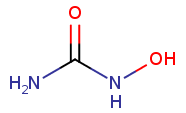
SGD curators use the Chemical Entities of Biological Interest (ChEBI) Ontology, maintained by EMBL-EBI, to describe chemicals used in experiments curated from yeast publications and displayed on SGD webpages.
You may have noticed that we have recently added chemical structures provided by ChEBI to the Chemical pages in SGD! Click the structure to zoom in, click again to zoom back out.
It’s a small detail, but we love this feature, and hope that you do too! Thanks, ChEBI!
Alliance of Genome Resources – Release 6.0
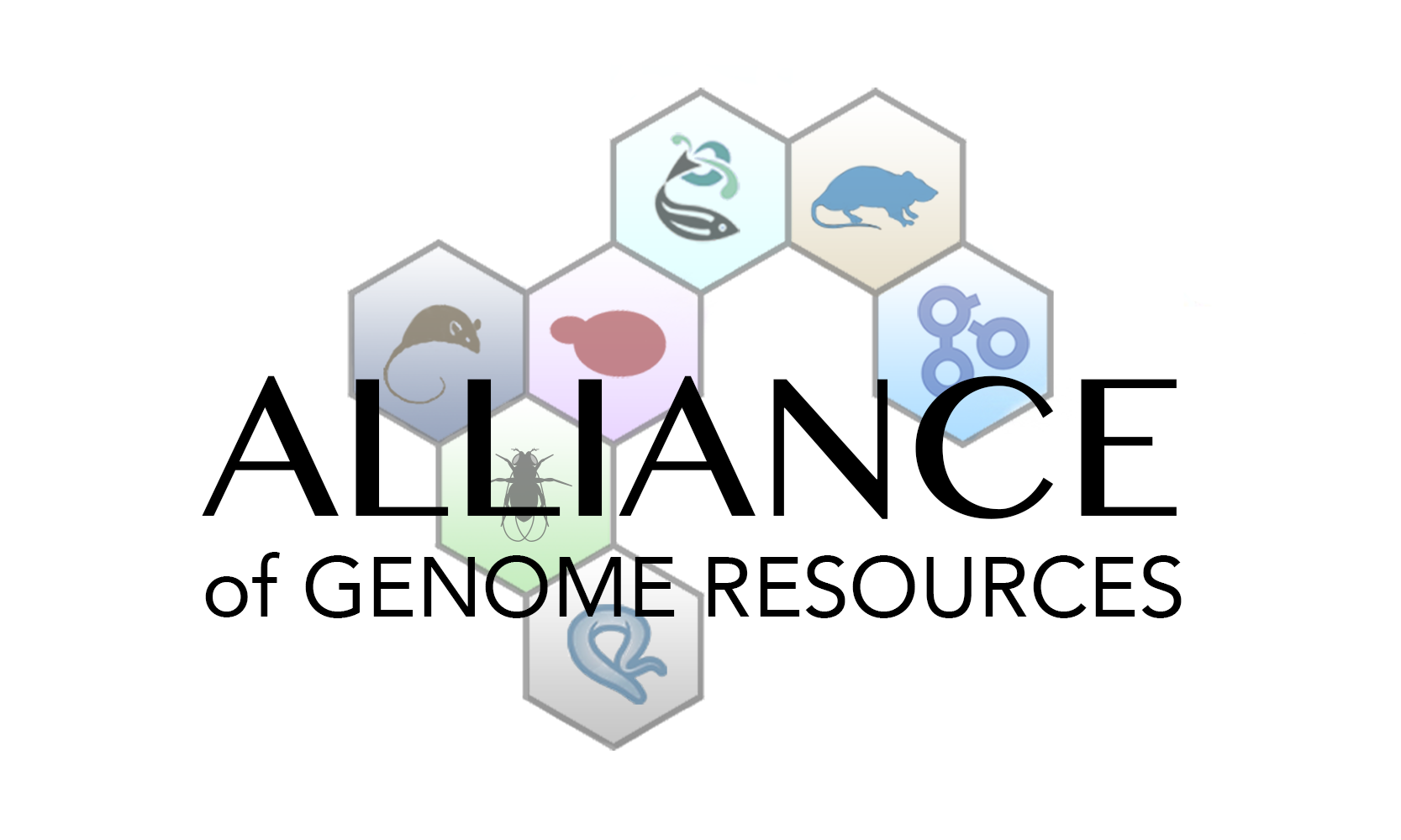
The Alliance of Genome Resources, a collaborative effort between SGD and other model organism databases (MOD), released version 6.0 in September 2023.
Version 6.0 adds new features to gene pages:
- New Paralogy section. Similar to Orthology, the Paralogy data are sourced from the DRSC’s DIOPT tool, which lets you view predictions from several tools at one time. Each table is ranked based on similarity, identity, alignment length, and a count of algorithms (methods) used to predict a paralogous match. See human HSPA1A gene page for an example.
- New Sequence Detail section. For different transcripts of the gene, you can choose to view the sequence for the gene, or its CDS, cDNA, protein, gene with collapsed introns, or genomic sequence with or without 500 bp up and downstream.
- Disease Qualifier. The qualifier describes whether a gene may be, for example, a marker_for the onset of a disease, or implicated_in the severity of a disease.
- Disease “Annotation details”. The pop-up for individual table rows has expanded to include Association, Additional Implicated Genes, Genetic Modifiers, Strain Background, Genetic Sex, Notes, and Annotation Type.
- The Download file from the gene page disease table now includes fields for Additional Implicated Gene ID, Additional Implicated Gene Symbol, Gene Association, Genetic Entity Association, Disease Qualifier, Evidence Code Abbreviation, Experimental Conditions, Genetic Modifier Relation, Genetic Modifier IDs, Genetic Modifier Names, Strain Background ID, Strain Background Name, Genetic Sex, Notes, Annotation Type, and Source URL.
- The Source column entries now link back to their respective resource webpages.
SGD’s Social Media Footprint is Expanding
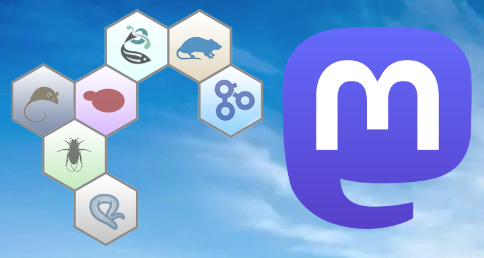
Discourse, Mastodon, BlueSky – oh my! Social media is in a chaotic period, with once tight-knit communities having been dismantled and thrown into the ether. SGD feels your pain; we have been searching for our audience, waiting for the stardust to settle, coagulate, coalesce…. In the interim, in an effort to reach you, we have set up SGD outposts on various platforms:
Discourse: The Alliance of Genome Resources Community Forum brings together communities of the major model organisms – yeast, worm, fly, zebrafish, frog, rat, and mouse – in one place. Users can create accounts to post announcements and questions, and chat with other researchers in a science-focused arena. Contact SGD for an invited account, which has additional permissions.
Mastodon: We’re just getting started with Mastodon; follow SGD at @yeastgenome@genomic.social
BlueSky: We’ve also just begun with BlueSky; follow SGD at @yeastgenome.bsky.social
We will be cross-posting to the various accounts – come find SGD on these platforms and we can navigate this latest social media adventure together!
Upcoming Conferences and Courses
- TAGC2024 The Allied Genetics Conference
- National Harbor | Washington DC Metro Area
- March 05 to March 10, 2024
- 32nd Fungal Genetics Conference
- Asilomar Conference Grounds, Pacific Grove, CA
- March 12 to March 17, 2024
- 16th Yeast Lipid Conference
- Saarland University, Homburg, Germany
- May 29 to May 31, 2024
- JCS2024: Diversity and Evolution in Cell Biology
- Montanya Hotel & Lodge, Catalonia, Spain
- June 24 to June 27, 2024
- 39th Small Meeting of Yeast Transporters and Energetics (SMYTE)
- University of York, York, United Kingdom
- August 28 to September 01, 2024
- ICY2024: 16th International Congress on Yeasts
- Cape Town International Convention Centre, Cape Town, South Africa
- September 29 to October 03, 2024
Happy Holidays from SGD!

We want to take this opportunity to wish you and your family, friends and lab mates the best during the upcoming holidays. Stanford University will be closed for two weeks starting December 21, reopening on January 4th, 2024. Although SGD staff members will be taking time off, the website will be up and running throughout the winter break, and we will resume responding to user requests and questions in the new year.
Note: If you no longer wish to receive this newsletter, please contact the SGD Help Desk at sgd-helpdesk@lists.stanford.edu.
Categories: Newsletter
Tags: Newsletter
SGD Newsletter, Summer 2023
June 22, 2023
About this newsletter:
This is the Summer 2023 issue of the SGD newsletter. The goal of this newsletter is to inform our users about new features in SGD and to foster communication within the yeast community. You can view this newsletter as well as previous newsletters, on the SGD Community Wiki .
Contents
- 1 Biochemical Pathways added to SGD Search
- 2 GENETICS Knowledgebase and Database Resources
- 3 SGD designated “Global Core Biodata Resource”
- 4 2D RNA structures from RNAcentral
- 5 CoSMoS.c. – Conserved Sequence Motif in Saccharomyces cerevisiae
- 6 microPublications – latest yeast papers
- 7 Alliance of Genome Resources – Releases 5.3 & 5.4
- 8 Upcoming Conferences and Courses
Biochemical Pathways added to SGD Search
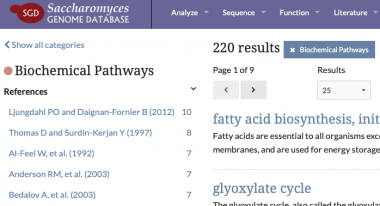
Biochemical pathways have been added to SGD search in order to facilitate easy access to metabolic yeast pathway pages at YeastPathways .
YeastPathways is a database of metabolic pathways and enzymes in the budding yeast Saccharomyces cerevisiae . YeastPathways content is manually curated and maintained by the curation team at SGD, your model organism database for budding yeast. Check it out! 👀 http://yeastgenome.org/search?q=&category=pathway
Manual curation of pathways is an ongoing process at SGD. We welcome feedback from the research community. Please feel free to contact us with any questions or comments.
GENETICS Knowledgebase and Database Resources
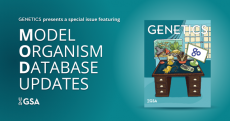
The May 2023 issue of GENETICS features the second annual collection of Model Organism Database articles.
Scientists from Alliance of Genome Resources member groups SGD , RGD , ZFIN , Gene Ontology , and Xenbase have provided updates on recent activities and innovations.
Be sure to browse the issue and get acquainted with these excellent Knowledgebase and Database Resource papers at GENETICS.
- SGD https://doi.org/10.1093/genetics/iyac191
- RGD https://doi.org/10.1093/genetics/iyad042
- ZFIN https://doi.org/10.1093/genetics/iyad032
- Gene Ontology (GO) https://doi.org/10.1093/genetics/iyad031
- Xenbase https://doi.org/10.1093/genetics/iyad018
SGD designated “Global Core Biodata Resource”

We are proud that SGD has been included in the first list of Global Core Biodata Resources (GCBRs) announced last December by the Global Biodata Coalition (GBC)! This collection of 37 resources comprises deposition databases which archive and preserve primary research data, and knowledgebases, such as SGD, that add value to research data through expert curation and annotation. The list is meant to highlight those data resources whose long term funding and sustainability is critical to life science and biomedical research worldwide.
GCBRs represent the most crucial resources within the global life science data community. SGD’s selection as a key global data resource recognizes that SGD is essential to the global research endeavor.
For more information regarding the Global Biodata Coalition, including a link to the full list of selected core biodata resources, please see the full press release from the GBC.
2D RNA structures from RNAcentral
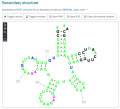
SGD recently updated our RNA pages to add secondary structures provided by RNAcentral and generated by R2DT .
Thumbnails and linkouts to RNAcentral via RNAcentral IDs are shown on the Summary and Sequence pages. Interactive secondary structure viewers are available on the Sequence pages.
Take the pages for a spin! For more information about the structures, please see the Help page at RNAcentral.
CoSMoS.c. – Conserved Sequence Motif in Saccharomyces cerevisiae
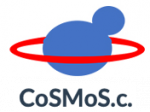
The new website CoSMoS.c. – Conserved Sequence Motif in Saccharomyces cerevisiae – may be of interest to investigators who study protein modifications in budding yeast. The new web-based search algorithm scores conservation of amino acid sequences based on whole-genome sequencing of 1000+ wild and domesticated yeast isolates.
In the recent publication describing the method , Li and Dohlman examined each of the 550 pairs of duplicated genes in S. cerevisiae , integrating 38,000+ documented post-translational modifications (PTMs), and 30,000+ reported interactions between protein kinases and substrates (all obtained from SGD !). More than 3,500 instances were identified where only one of two paralogous proteins undergoes a PTM despite having retained the same amino acid residue in both. Li and Dohlman found that the most common modifications – phosphorylation, ubiquitylation and acylation, but not N-glycosylation – occur in regions of high sequence conservation. The analysis indicates that differences in PTMs may be an important source of protein neo- or sub-functionalization, and that such differences likely account for the retention of closely related enzymes throughout evolution.
You can find links to CoSMoS.c. at the bottom of your favorite protein page at SGD, in the Resources section under Post-translational Modifications.
microPublications – latest yeast papers

microPublication Biology is part of the emerging genre of rapidly-published research communications. We are seeing a strong set of microPublications come through the database and are glad for this venue to publish brief, novel findings, negative and/or reproduced results, and results which may initially lack a broader scientific narrative. Each article is peer-reviewed, assigned a DOI, and indexed through PubMed and PubMedCentral.
Consider microPubublications when you have a result that doesn’t necessarily fit into a larger story, but will be of value to others.
Latest yeast microPublications:
- Daraghmi MM, et al. (2023) Macro-ER-phagy receptors Atg39p and Atg40p confer resistance to aminoglycoside hygromycin B in S. cerevisiae. MicroPubl Biol 2023
- Domeni Zali G and Moriel-Carretero M (2023) Auxin alone provokes retention of ASH1 mRNA in Saccharomyces cerevisiae mother cells. MicroPubl Biol 2023
- Hiestand L, et al. (2023) Chemical Genetics Screen of EVP4593 Sensitivity in Budding Yeast Identifies Effects on Mitochondrial Structure and Function. MicroPubl Biol 2023
- Liu L, et al. (2023) A role for ion homeostasis in yeast ionic liquid tolerance. MicroPubl Biol 2023
- Longan ER, et al. (2023) ADATscan – A flexible tool for scanning exomes for wobble inosine-dependent codons reveals a neurological bias for genes enriched in such codons in humans and mice. MicroPubl Biol 2023
- Miles S, et al. (2023) BY4741 cannot enter quiescence from rich medium. MicroPubl Biol 2023
- Moresi NG, et al. (2023) Caffeine-tolerant mutations selected through an at-home yeast experimental evolution teaching lab. MicroPubl Biol 2023
- Shortt C, et al. (2023) A simple and accessible CRISPR genome editing laboratory exercise using yeast. MicroPubl Biol 2023
All yeast microPublications can be found in SGD .
Alliance of Genome Resources – Releases 5.3 & 5.4

The Alliance of Genome Resources , a collaborative effort from SGD and other model organism databases (MOD), released version 5.3 last October and version 5.4 this past April.
Version 5.3 saw the addition of Xenopus data from Xenbase. These amphibians are an important tetrapod model, spanning the evolutionary gap between the mammalian (human, mouse, and rat) and zebrafish data already included in the Alliance. Xenopus have long been used in developmental and cell biology, and two species are widely studied. The African clawed frog, X. laevis is an allotetraploid (2n = 36) of hybrid origin. The resulting X. laevis genome has a set of ‘long’ and ‘short’ chromosomes and gene symbols are therefore appended with ‘.L’ or ‘.S’ denoting on which chromosome pair they reside. The second Xenopus species, the Western clawed frog X. tropicalis , is a conventional diploid (2n=20), and is increasingly used in human disease modeling.
Data for both Xenopus species are organized on individual gene pages that feature data such as gene descriptions, orthology to human and other species, disease associations for orthologs, an expression ribbon view, and a Sequence Feature Viewer.
Version 5.4 provides new Alliance SimpleMine and Facebook URLs:
- SimpleMine allows basic batch searches of Alliance data: https://www.alliancegenome.org/agr_simplemine.cgi
- The Alliance of Genome Resources has a new Facebook page: https://www.facebook.com/AllianceOfGenomeResources
Upcoming Conferences and Courses
- Pacific Northwest Yeast Club
- Western Washington University, Bellingham, WA
- July 20, 2023
- Yeast Genetics & Genomics – modern and intensive laboratory course that teaches students the full repertoire of genetic and genomic approaches needed to dissect complex problems using the yeast Saccharomyces cerevisiae
- Cold Spring Harbor Laboratory, NY
- July 26 – August 15, 2023
- 2023 Northeast Regional Yeast Meeting (NERY 2023)
- Cornell University, Ithaca, NY
- July 27 to July 28, 2023
- ICYGMB31 – 31st International Conference on Yeast Genetics and Molecular Biology
- Florence, Italy
- August 20 to August 25, 2023
- 38th Small Meeting on Yeast Transport and Energetics (SMYTE)
- Blankenberge, Belgium
- September 13 to September 17, 2023
- CSH Asia: Yeast and Life Sciences
- Kunibiki Messe (Shimane Prefectural Convention Center), MATSUE, JAPAN
- October 09 to October 13, 2023
- ISSY2023: Yeast Biotech 2.0
- National Wine Centre of Australia, Adelaide SA, Australia
- November 27 to December 01, 2023
- TAGC2024 The Allied Genetics Conference
- National Harbor | Washington DC Metro Area
- March 05 to March 10, 2024
- 32nd Fungal Genetics Conference
- Asilomar Conference Grounds, Pacific Grove, CA
- March 12 to March 17, 2024
- ICY2024: 16th International Congress on Yeasts
- Cape Town International Convention Centre, Cape Town, South Africa
- September 29 to October 03, 2024
Categories: Newsletter
SGD Newsletter, Summer 2022
July 28, 2022
About this newsletter:
This is the Summer 2022 issue of the SGD newsletter. The goal of this newsletter is to inform our users about new features in SGD and to foster communication within the yeast community. You can view this newsletter as well as previous newsletters on our Community Wiki.
Performance updates at SGD
Thousands of SGD users run their data against SGD data every day and this can put a heavy load on servers. To improve performance, we have invested in dockerizing our full database so that loads can be better distributed in real time. We are currently at the stage of testing the frontend of our software to look for bugs, which we do for every update. The next phase will entail dockerizing and testing the backend, so we can improve our data uploads.
We hope to see improved performance for you, our users. If you happen to notice faster speeds or fewer hiccups…we’d be quite glad to hear about it! (A message to the SGD Helpdesk reaches us all.)
Research Spotlights are back
SGD triages all the papers that come out each week to find those that add value to our database. In the process, we are continually impressed by the quality of the research done in yeast and we decided it was time to bring back the “Research Spotlight” as a post that appears on the SGD home page in the “New and Noteworthy” section.
The goal is to highlight interesting new work that either continues an ongoing story, makes a twist in the story we all thought we knew (such as an unexpected side gig for a protein), or offers a new technique or perspective for mining the most value from the yeast model. There are numerous intriguing papers in yeast, including those shedding light on human disease by dissecting the cellular biology in yeast, using our remarkable tools, so as to identify new targets or drugs for humans.
As the model organism databases move toward forming the Alliance of Genome Resources, which will streamline and integrate our combined data, we expect this power to make useful connections will only grow.
Upcoming Yeast Genetics Meeting
We may have forgotten how to talk to other people in person, but the Yeast Genetics Meeting is going to give us a chance to practice. The meeting will be held in person for the first time in four years at UCLA, from August 17-21. We hope to see you there!
Of course, it being the COVID era, you can also register to attend virtually, and the cost will not be higher for late registration.
A big congratulations to the award recipients who are the invited speakers for 2022. Tom Petes is receiving the YGM Lifetime Achievement Award, Trisha Davis is giving the Winge-Lindegren Address, Maya Schuldiner is receiving the Ira Herskowitz Award, and Michael Desai is giving the Lee Hartwell Lecture. Learn more about these researchers and their work at the YGM website.
Congratulations to Jeremy Thorner
While on the subject of congratulations, a past recipient of the YGM Lifetime Achievement Award and a longtime friend and advisor of SGD has been further honored with a full issue of the journal Biomolecules dedicated to his work, Transmembrane and Intracellular Signal Transduction Mechanisms: A Themed Issue in Honor of Professor Jeremy Thorner
We are grateful to have Dr. Thorner’s work integrated into the SGD database and into our wider community’s ongoing mission to understand yeast.
SGD collaborates to add new data links
On the topic of integration, SGD is happy to integrate new data sets that add value to the database. We have the ability to incorporate these datasets directly from research groups, rather than from publications. Most recently we integrated the AlphaFold predicted 3D structures for complexes as links on the SGD Interaction and Protein pages. It is now possible to look for your own proteins or complexes of interest and go straight to the predicted structure.
Another recent example is AnalogYeast, a dataset of analogs to yeast proteins in non-fungal organisms predicted by sequence similarity, which was created by the Schuldiner lab. Links have been added to the Resources sections of SGD Protein and Homology pages.
We are open to more of this collaboration and would be glad to hear from community members who think they have data useful to other researchers. Get in touch!
microPublications enter log phase
microPublication is part of the emerging genre of rapidly-published research communications. We are seeing a strong set of microPublications come through the database and are glad for this venue to publish brief, novel findings, negative and/or reproduced results, and results which may lack a broader scientific narrative. Each article is peer-reviewed, assigned a DOI, and indexed through PubMed and PubMedCentral.
Consider microPubublications when you have a result that doesn’t necessarily fit into a larger story, but will be of value to others.
To see recent micropublications in yeast, visit the list of micropubs in SGD.
Alliance of Genome Resources – Release 5.2
The Alliance of Genome Resources, a collaborative effort from SGD and other model organism databases (MOD), released version 5.2 this past May.
- The Alliance is now using the latest version of the DRSC Integrative Ortholog Prediction Tool (DIOPT): Version 9. This version includes a data refresh from all orthology sources, the addition of the SonicParanoid algorithm, and the removal of both TreeFam and RoundUp data sources.
- Much of this release focused on backend enhancements, particularly the continued efforts to develop software to provide a single interface for Alliance curators from all the Model Organism Databases (MODs). This single interface will reduce software development redundancies and free up resources for new features. Future releases will continue to add more modules for entering different data types.
Upcoming Conferences and Courses
- Yeast Genetics & Genomics – modern and intensive laboratory course that teaches students the full repertoire of genetic and genomic approaches needed to dissect complex problems using the yeast Saccharomyces cerevisiae
- Cold Spring Harbor Laboratory, NY
- July 26 – August 15, 2022
- Yeast Genetics Meeting – the premier meeting for students, postdoctoral scholars, research staff, and principal investigators studying various aspects of eukaryotic biology in yeast
- University of California, Los Angeles
- August 17 – 21, 2022
- Gene Ontology Consortium Fall Meeting
- Virtual plus in person
- California Institute of Technology, Pasadena
- October 11 – 13, 2022
- Fungal Pathogen Genomics – Hands-on training in web-based data-mining resources for fungal genomes
- Wellcome Genome Campus, Hinxton, Cambridge, UK
- May 07 to May 12, 2023
Categories: Newsletter
SGD Newsletter, Fall 2021
December 14, 2021
About this newsletter:
This is the Fall 2021 issue of the SGD newsletter. The goal of this newsletter is to inform our users about new features in SGD and to foster communication within the yeast community. You can view this newsletter as well as previous newsletters on our Community Wiki.
Contents
- 1Protein Complex Page Updates
- 2Nomenclature Updates
- 3New links to AlphaFold 3D Predicted Protein Structure Database
- 4DIOPT Orthologs and new queries in YeastMine
- 5Alliance of Genome Resources – latest release
- 6Upcoming Conferences and Courses
- 7Gene Ontology Consortium Fall 2021 Meeting
- 8Happy Holidays from SGD!
Protein Complex Page Updates

SGD has made recent updates to our protein complex pages to improve clarity and ease of use. The new pages for each complex will have the same format as gene pages, with tabs across the top for each category of information, including a Summary page, a Gene Ontology page, and a Literature page. Just as we do for all of your favorite genes, Gene Ontology and Literature curation for complexes will be ongoing.
If you have any questions or feedback about the updates to our complex pages, please do not hesitate to contact us at any time.
Nomenclature Updates
SGD has long been the keeper of the official Saccharomyces cerevisiae gene nomenclature. Robert Mortimer handed over this responsibility to SGD in 1993 after maintaining the yeast genetic map and gene nomenclature for 30 years.
The accepted format for gene names in S. cerevisiae comprises three uppercase letters followed by a number. The letters typically signify a phrase (referred to as the “Name Description” in SGD) that provides information about a function, mutant phenotype, or process related to that gene, for example “ADE” for “ADEnine biosynthesis” or “CDC” for “Cell Division Cycle”. Gene names for many types of chromosomal features follow this basic format regardless of the type of feature named, whether an ORF, a tRNA, another type of non-coding RNA, an ARS, or a genetic locus. Some S. cerevisiae gene names that pre-date the current nomenclature standards do not conform to this format, such as MRLP38, RPL1A, and OM45.
A few historical gene names predate both the nomenclature standards and the database, and were less computer-friendly than more recent gene names, due to the presence of punctuation. SGD recently updated these gene names to be consistent with current standards and to be more software-friendly by removing punctuation. The old names for these four genes have been retained as aliases.
Legacy gene names
| ORF | Old gene name | New gene name |
|---|---|---|
| YGL234W | ADE5,7 | ADE57 |
| YER069W | ARG5,6 | ARG56 |
| YBR208C | DUR1,2 | DUR12 |
| YIL154C | IMP2′ | IMP21 |
New systematic nomenclature for yeast genes not in the reference genome
For many years, a widely adopted systematic nomenclature has existed for yeast protein-coding genes, or ORFs, as many yeast researchers call them. Readers of the last SGD newsletter will recall that, earlier this year, SGD adopted a new systematic nomenclature for the entire annotated complement of ncRNAs.
We have just put into place a new systematic nomenclature for S. cerevisiae genes that are not found in the reference genome of strain S288C (“non-reference” genes). This new systematic nomenclature is similar to, but distinct from, that used for ORFs and that used for ncRNAs. Non-reference genes are designated by a symbol consisting of three uppercase letters and a four-digit number, as follows: Y for “Yeast”, SC for “Saccharomyces cerevisiae”, and a four-digit number corresponding to the sequential order in which the gene was added to SGD. We currently have 55 of these genes in SGD, some of which are old favorites like MAL21/YSC0004 and MATA/YSC0046, while others are more recent additions like XDH1/YSC0051. Going forward, as evidence is published pointing to other S. cerevisiae genes not present in the S288C reference genome, they will be added to the annotation using the next sequential number available. We already have 15 more of these YSC0000 names reserved by researchers and awaiting publication.
If you have some non-reference genes for which these names would be appropriate, please let us know!
New links to AlphaFold 3D Predicted Protein Structure Database
Would you like to see the shape of your protein?
SGD now contains links to AlphaFold in the Resources sections of the Summary, Protein, and Homology pages for every gene.
- The links through SGD give quick access to EMBL’s European Bioinformatics Institute (EMBL-EBI), which offers a new, highly accurate tool for predicting protein structure with speed and clarity.
- Given a peptide sequence for an uncharacterized protein, AlphaFold will model predicted domains and provide relative confidence levels for each portion of the prediction.
- The predicted domains can then be compared to known protein structures (using a tool such as PDBeFold) to seek matches to characterized protein families.
- Whether or not a family is identified, the comparison will yield clues to protein function to help design the next experiments.
DIOPT Orthologs and New Queries in YeastMine
We recently replaced HomoloGene, Ensembl, TreeFam and PANTHER homology datasets in YeastMine with homology data from DIOPT (DRSC integrative ortholog prediction tool). DIOPT integrates orthology predictions from multiple sources, including HomoloGene, Ensembl, TreeFam, and PANTHER. Using the Gene->Non-fungal and S. cerevisiae Homologs pre-generated query, you can look for DIOPT homologs for a single or multiple yeast genes. The results table provides identifiers and standard names for the yeast and homologous genes, as well as organism and predictive score information. As with other YeastMine templates, results can be saved as lists and analyzed further.
Pre-generated queries for human homolog(s) of your favorite yeast gene and their corresponding disease associations remain largely unchanged. You can begin with your favorite human gene or disease keyword and retrieve the yeast counterparts of the relevant gene(s). As an example, you can search for the S. cerevisiae homologs of all human genes associated with disorders that contain the keyword “diabetes” (view search). The results table provides identifiers and standard names for the yeast and human genes, OMIM gene and disease identifiers and name, as well as predictive algorithm sources and scores.
Alliance of Genome Resources – Recent Release
The Alliance of Genome Resources, a collaborative effort from SGD and other model organism databases (MOD), released version 4.1 this past August. Notable improvements and new features include:
- Human and model organism high throughput (HTP) variant data
- Human variants are imported from Ensembl
- Model organism HTP variants are submitted by Alliance members (FlyBase, RGD, SGD, Wormbase) or imported from EVA (MGI and ZFIN).
- Added HTP variants to the Alleles and Variants table on gene pages (e.g. rat Lepr Gene page) and to the table on the Alleles and Variants Details page (e.g. rat Lepr Alleles and Variants Details.
- Created a report page for Human and model organism HTP variants (e.g. human variant rs1041354454).
- Expanded Allele Category in search to “Allele/Variant” and added a search for HTP variants.
- On Gene Pages, a new Pathways widget displays via tabs:
- Reactome models of pathways for human gene products as well as inferred pathways for model organism genes based on orthology to human genes.
- Reactome reactions for gene products (e.g. human TP53 Gene page)
- Gene Ontology Causal Activity Models (GO-CAMs). These provide a framework to represent a biological system by linking together multiple GO annotations. PMID:31548717 (e.g. worm nsy-1 Gene page).
- Experimental conditions are include for Disease and Phenotype data in tables on Gene, Allele, and Disease pages (e.g. zebrafish scn1lab Gene page).
- AllianceMine added Orthologs, and Allele and Variants (low throughput) data types to this release. You can now query for these data types via pre-made template queries.
- The Alliance Community Forum is released. The Forum permits discussions across six model organism communities—flies, mice, yeast, rats, worms, and zebrafish. More details will follow.
Upcoming Conferences and Courses
- Fungal Genetics – the premier meeting for the international community of fungal geneticists
- Asilomar Conference Grounds, Pacific Grove, California (and Online)
- March 15 – 20, 2022
- 36th International Specialised Symposium on Yeasts (ISSY36) – Yeast Sea to Sky – Yeast in the Genomics Era
- University of British Columbia, Vancouver
- July 12 – 16, 2022
- CSHL Yeast Genetics & Genomics – modern, intensive laboratory course that teaches students full repertoire of genetic and genomic approaches
- Cold Spring Harbor Laboratory, NY
- July 26 – August 15, 2022
- Yeast Genetics Meeting – the premier meeting for students, postdoctoral scholars, research staff, and principal investigators studying various aspects of eukaryotic biology in yeast
- University of California, Los Angeles
- August 17 – 21, 2022
Gene Ontology Consortium Fall 2021 Meeting
From October 12-14, SGD biocurators attended the Gene Ontology Consortium’s Fall Meeting with participants from around the world. The goal of these meetings is to bring together data scientists with diverse backgrounds (curators, programmers, etc.) for lively discussions regarding how to better capture, curate, analyze, and serve data to researchers, educators, students, and other life science professionals. Our goal in participating in these meetings each year is to find ways to make SGD even better for you!
Discussion topics included, but were not limited to:
- LitSuggest – web-based system for biomedical literature recommendation and curation
- ECO, Evidence and Conclusions Ontology – terms used to describe types of evidence and assertion methods
- PAINT, Phylogenetic Annotation and INference Tool from PANTHER – orthology between reference genome genes and human disease genes
Happy Holidays from SGD!
We know that 2021 has been another challenging year for everyone. Our thoughts go out to all those who have been impacted by recent events. We wish you and your family, friends, and lab mates the best during the upcoming holidays.
Stanford University will be closed for two weeks starting December 20, and will reopen on January 3rd, 2022. Although SGD staff members will be taking time off, the website will be up and running throughout the winter break, and we will resume responding to user requests and questions in the new year.
Categories: Newsletter
Tags: Newsletter, Saccharomyces cerevisiae
SGD Newsletter, Spring 2021
May 27, 2021
About this newsletter:
This is the Spring 2021 issue of the SGD newsletter. The goal of this newsletter is to inform our users about new features in SGD and to foster communication within the yeast community. You can view this newsletter as well as previous newsletters on our Community Wiki.
Contents
- R64.3 Annotation Update
- New Homology Pages
- Functional Complementation Data Available on References Pages
- YeastMine Updates and New Templates
- Textpresso Central Update
- Number of Curated Alleles Continues to Grow
- Alliance of Genome Resources – Disease Associations for model organisms
- Fungal Pathogen Genomics Workshop
R64.3 Annotation Update
SGD curators periodically update the chromosomal annotations of the S. cerevisiae Reference Genome, which is derived from strain S288C.
The R64.3 annotation release, dated 2021-04-21, included various updates and additions:
- 7 new ORFs: OTO1/YGR227C-A, YHR052C-B, YHR054C-B, YJR107C-A, YKL104W-A, YLR379W-A, YMR008C-A
- 5 new ncRNAs: GAL10-ncRNA, TBRT/XUT_2F-154, SUT169, PHO84 lncRNA, GAL4 lncRNA
- 2 new uORFs for ROK1/YGL171W
- 1 new recombination enhancer: RE
- 1 new LTR: YELWdelta27
- 3 ORFs with shifted translation starts: HPA3/YEL066W, YJR012C, LTO1/YNL260C
- 1 ORF with shifted translation stop plus new intron: LDO45/YMR147W
- Changed feature_type (and SO_term) for non-transcribed spacers: NTS1-2, NTS2-1, NTS2-2
- New systematic nomenclature system for entire annotated complement of ncRNAs
Various sequence and annotation files are available on SGD’s Downloads site. You can find more update details and read about the new systematic nomenclature system for noncoding RNA genes on the Details of 2021 Reference Genome Annotation Update R64.3 SGD Wiki page.
New Homology Pages
SGD is excited to introduce our new Homology Pages! These pages can be accessed by clicking on the Homology tab in the header of SGD gene pages, as seen below.
The information displayed on the Homology Pages is divided into several sections:
- Homologs: Information about known homologs for the gene of interest, such as the species of the homolog, the corresponding Gene ID from the Alliance of Genome Resources, and the name of the homolog.
- Functional Complementation: Data about cross-species functional complementation between yeast and other species, curated by SGD and the Princeton Protein Orthology Database (P-POD).
- Fungal Homologs: Curated homolog information for 24 additional species of fungi. View the species of the fungal homolog, the database source of the entry, and the Gene ID of the homolog from that database.
- External Identifiers: A list of external identifiers for the protein from various database sources.
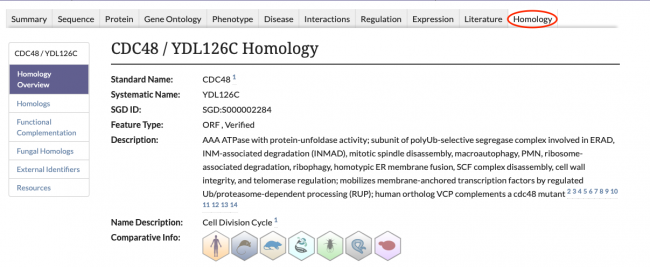
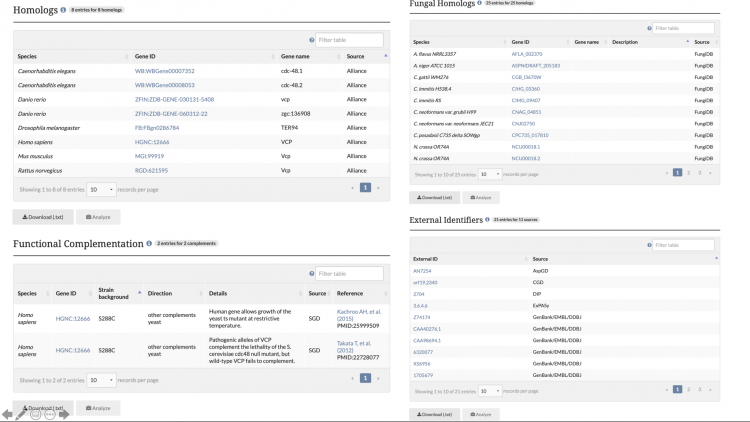
Functional Complementation Data Available on References Pages
Functional Complementation annotations are now viewable on reference pages for which there is curatable functional complementation data. This information describes cross-species functional complementation between yeast and other species, and is curated by SGD and the Princeton Protein Orthology Database (P-POD).
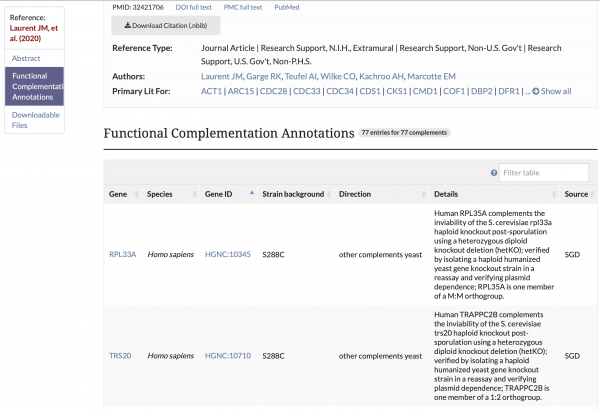
YeastMine Updates and New Templates
SGD has updated the current Gene–>UTRs YeastMine template with newly calculated 5′ and 3′ UTR sequence/coordinates. Additionally, transcript iso-forms for specific genes from the Pelachano et al., 2013 study can be accessed in YeastMine using the new Gene–>Transcripts template. Both templates can be found under the “Templates” section of YeastMine under the “Expression” category.
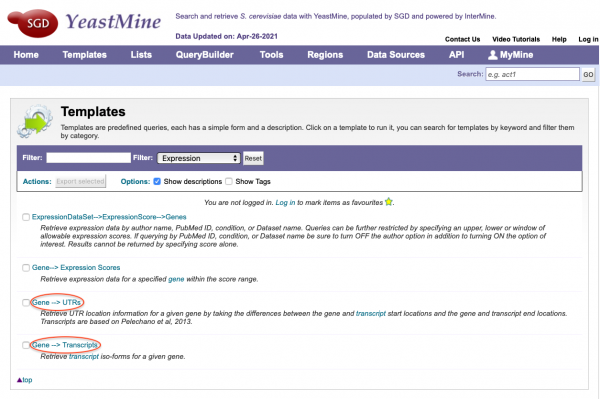
Textpresso Central Update
Textpresso has recently been updated with a new system, adopting an overhauled user interface and introducing several new features including:
- Search results shown in the context of the full text
- Custom corpus creation
- Customizable annotation interface
- Search terms are highlighted in full-text view
Textpresso Central can also be accessed by clicking on “Full-text Search” under the Literature pull-down menu on the home page of SGD. More information about the changes and types of papers stored in Textpresso can be found in their About Us help section or (from Müller et al., 2018).
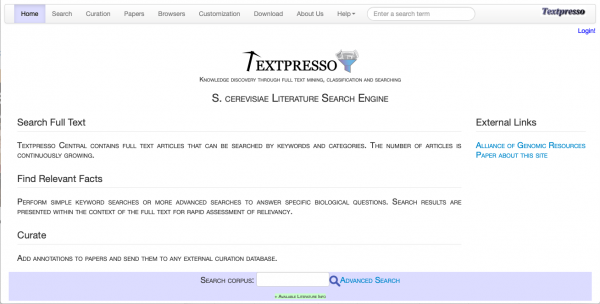
Number of Curated Alleles Continues to Grow
SGD now has approximately 13,000 alleles that are either fully or partially curated. To navigate to an allele page, use the search bar to find a specific allele or enter a gene name and select an allele from the autocomplete list. Additionally, these pages can be accessed by clicking on the allele name in a gene’s Phenotype Annotation table. SGD Curators continue to add new alleles or update existing ones as new information becomes available.
You can generate a list of all alleles in our database or find alleles for a specific gene using the Genes –> Alleles template in YeastMine.
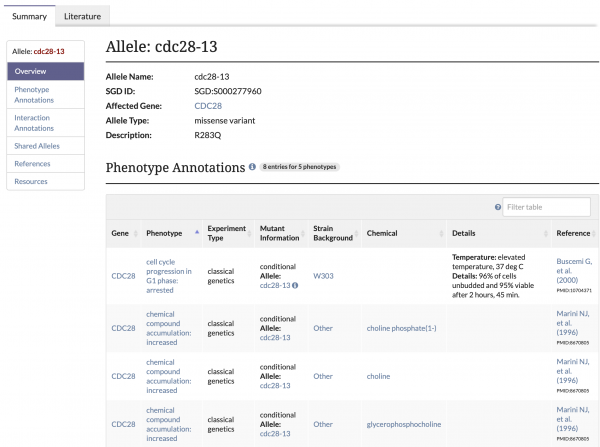
Alliance of Genome Resources – Disease Associations for model organisms
Did you know that you can find human disease associations for yeast genes and their orthologs in other key model organisms at the Alliance of Genome Resources?
SGD is a founding member of the Alliance of Genome Resources, which was established to facilitate the use of diverse model organisms in understanding the genetic and genomic bases of human biology, health, and disease. Gene pages for yeast and other model organisms at the Alliance include a section for Disease Associations, including those for orthologous genes. Human diseases are represented using the Disease Ontology (DO).
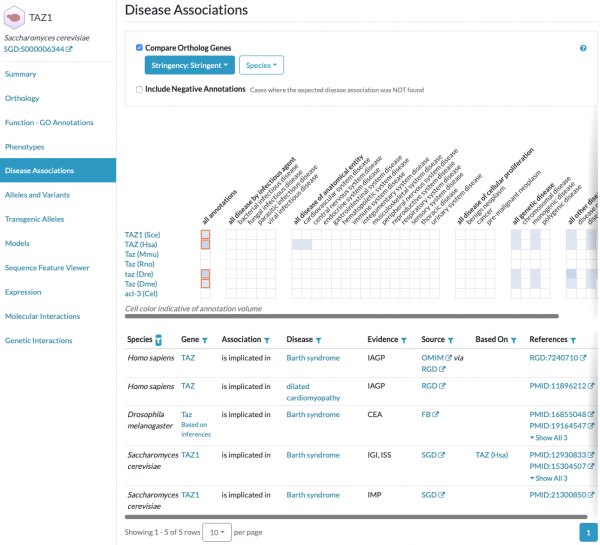
Fungal Pathogen Genomics Workshop
From May 10th – 14th, Senior Biocuration Scientist Edith Wong, Senior Biocuration Scientist Rob Nash, Senior Biocuration Scientist Marek Skrzypek, Biocuration Scientist Suzi Aleksander, and Associate Biocuration Scientist Micheal Alexander were instructors for the Virtual Fungal Pathogen Genomics Workshop hosted by Wellcome Connecting Science. Our curators helped attendees learn more about the unique tools hosted on our website and provided them the opportunity to learn about other curation tools from FungiDB, EnsemblFungi, CGD, MycoCosm, and JGI.
We would like to thank the Fungal Pathogen Genomics team for facilitating a successful virtual workshop, and for providing excellent training in web-based data mining resources for all attendees.

Categories: Newsletter
SGD Newsletter, Fall 2020
December 08, 2020
About this newsletter:
This is the Fall 2020 issue of the SGD newsletter. The goal of this newsletter is to inform our users about new features in SGD and to foster communication within the yeast community. You can view this newsletter as well as previous newsletters on our community Wiki.
Contents:
- New SGD Allele Pages
- Interaction Page Updates
- Links on SGD gene pages to homolog gene pages at the Alliance of Genome Resources
- Alliance of Genome Resources at Version 3.2
- Jeremy Thorner Retiring
- YeaZ system for microscopy images
- In Memoriam: Angelika Amon
- Gene Ontology Consortium Meeting
- Happy Holidays from SGD!
New SGD Allele Pages

We are pleased to announce that SGD’s brand new Allele Pages are now available on our website. To navigate to an allele page, use the search bar to find a specific allele or enter a gene name and select an allele from the autocomplete list. Additionally, these pages can be accessed by clicking on the allele name in a gene’s Phenotype Annotation table. These pages are still being updated with new information as it becomes available. The type of information that you can find on each allele page includes:
- Allele Overview: General information about the allele, such as its name, the affected gene, the type of allele (e.g. missense), and a description of sequence change and/or domain mutated.
- Phenotype and Interaction Annotations: Phenotype and Genetic Interaction Annotation tables for the allele.
- Shared Alleles: A network diagram depicting shared phenotypes and interactions with other alleles.
If you are interested in viewing all alleles for a specific gene or would like to view a comprehensive list of the alleles that SGD currently has curated, you can use this YeastMine template with your customized parameters.
Interaction Page Updates
SGD has made recent updates to our Gene Interactions Page for improved clarity. Previously, genetic and physical interaction annotations were combined in one table, but now these annotations are recorded in separate annotation tables. The menu in the top left corner can be used to view and navigate to each section of the Interactions page. Additionally, alleles, SGA Scores, and P-values are now included for annotations from the global interactions paper by Costanzo M, et al. (2016) .

Links on SGD gene pages to homolog gene pages at the Alliance of Genome Resources


Previously, the ‘Comparative Info’ section on the Gene Summary page contained a link to the Alliance of Genome Resources if integrated model organism details were available. Now, users will instead find hexagonal buttons representing each model organism (human, mouse, rat, zebrafish, fly, and worm) for which there is homologous gene information at the Alliance of Genome Resources. Clicking on the link will immediately direct the user to the gene page for the selected model organism on the Alliance website.
Alliance of Genome Resources at Version 3.2

The Alliance of Genome Resources , a collaborative effort from SGD and other model organism databases (MOD), released version 3.2 in October. Notable improvements and new features include:
- Gene pages now display transgenic allele data under the ‘Transgenic Allele’ section.
- Allele and Variant sections on Gene pages have improved formatting and are now downloadable.
- “NOT” disease annotations are shown in Disease, Alleles and Variants, and Models sections when an anticipated disease annotation was not found.
- Enhanced variant data representation on Allele pages.
- High-throughput profiling experiment metadata can be searched and will display in the search results as HTP Dataset Index.
- The Alliance User Community discussion forum has been released.
Jeremy Thorner Retiring

Jeremy Thorner, a prolific yeast researcher and outstanding mentor, has announced that his lab is closing. His lab provided the following notice:
“After 47 years at the University of California, Berkeley, the laboratory of Professor Jeremy Thorner will be closing permanently, as of 30 June 2021. After that date, there will be no way to distribute any strains, plasmids, enzymes, or antibodies generated during the course of the studies on Saccharomyces cerevisiae conducted by the Thorner laboratory over those many years.”
YeaZ system for microscopy images

YeaZ is a system for efficiently and accurately segmenting microscopy images of yeast cells. It contains a convolutional neural network, with an underlying training set of high-qual|ty segmented yeast images, as well as a graphical user interface and a web application to employ, test, and expand the system. The system contains a Python based application with graphical user interface available on GitHub , as well as standalone apps for both Windows and Mac based computers, and training sets. Additional information is available in the accompanying Nature Communications paper by Dietler et al., 2020 .
YeaZ was created at École polytechnique fédérale de Lausanne (EPFL), Lausanne, Switzerland. Please contact Sahand Jamal Rahi with questions, or ideas for improvements.
In Memoriam: Angelika Amon

It was with great sadness that we learned that Angelika Amon, cell biologist and Professor of Biology at MIT and a member of the Koch Institute for Integrative Cancer Research, passed away on October 29, 2020. Angelika was widely known for her novel contributions to the field of cell biology and proliferation, with her research focusing on aneuploidy and the consequences of chromosome mis-segregation. At the beginning of Angelika’s career, her work on yeast genetics led to the discovery that cyclins must break down completely before cells progress from mitosis to G1.
Her research has helped shape the current understanding of cell division, and her passion for genetics will live on through her students and colleagues who continue her work. Angelika was a treasured part of the genetics community and will be missed dearly.
The Genetics Society of America has featured a tribute piece in remembrance of Angelika Amon , written by her friend and colleague, Orna Cohen-Fix.
Gene Ontology Consortium Meeting

From October 6th-8th, PI Mike Cherry, Senior Biocuration Scientist Edith Wong, Senior Biocuration Scientist Rob Nash, Senior Biocuration Scientist Marek Skrzypek, Biocuration Scientist Suzi Aleksander, and Associate Biocuration Scientist Micheal Alexander attended the Gene Ontology Consortium meeting. Suzi presented on SGD’s GO display and GO tools, and curators learned more about how other databases utilize GO. SGD Curators also participated in meaningful discussions about improving existing GO resources while also helping with the planning of new GO projects.
We would like to thank The Gene Ontology for facilitating this successful change to a virtual conference and holding an accessible, well received event for the entire model organism community!
Happy Holidays from SGD!
We would like to take this opportunity to recognize that 2020 has brought many changes and challenges for everyone. Our thoughts go out to all those who have been impacted by the unprecedented events of this year.
We wish you and your family, friends, and lab mates the best during the upcoming holidays. Stanford University will be closed for three weeks starting on December 14 and will reopen on January 4th, 2021 . Although SGD staff members will be taking time off, the website will be up and running throughout the winter break, and we will resume responding to user requests and questions in the new year.
Categories: Newsletter
